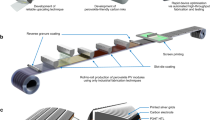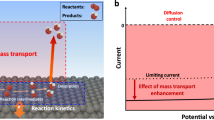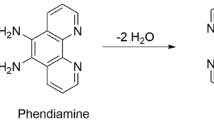Abstract
Achieving high current densities while maintaining high energy conversion efficiency is one of the main challenges for enhancing the competitiveness of photo-electrochemical devices. We describe a concept that allows this challenge to be overcome by operating under concentrated solar irradiation (up to 474 kW m−2), using thermal integration, mass transport optimization and a close electronic integration between the photoabsorber and electrocatalyst. We quantify the increase in the theoretical maximum efficiencies resulting from thermal integration, and experimentally validate the concept using a III–V-based photoabsorber and IrRuOx–Pt-based electrocatalysts. We reach current densities higher than 0.88 A cm−2 at calculated solar-to-hydrogen conversion efficiencies above 15%. Device performance, dynamic response and stability are investigated, demonstrating the ability to produce hydrogen stably under varying conditions for more than two hours. The current density and output power (27 W) achieved provide a pathway for device scalability aimed towards the large-scale deployment of photo-electrochemical hydrogen production.
This is a preview of subscription content, access via your institution
Access options
Access Nature and 54 other Nature Portfolio journals
Get Nature+, our best-value online-access subscription
$29.99 / 30 days
cancel any time
Subscribe to this journal
Receive 12 digital issues and online access to articles
$119.00 per year
only $9.92 per issue
Buy this article
- Purchase on Springer Link
- Instant access to full article PDF
Prices may be subject to local taxes which are calculated during checkout




Similar content being viewed by others
Data availability
The datasets generated and/or analysed during the current study are available from the corresponding author on reasonable request. Data used to create Fig. 4 and Supplementary Table 6 are available publically via the http://specdc.epfl.ch/ tool.
References
Pagliaro, M., Konstandopoulos, A. G., Ciriminna, R. & Palmisano, G. Solar hydrogen: fuel of the near future. Energy Environ. Sci. 3, 279–287 (2010).
Pinaud, B. A. et al. Technical and economic feasibility of centralized facilities for solar hydrogen production via photocatalysis and photoelectrochemistry. Energy Environ. Sci. 6, 1983–2002 (2013).
Shaner, M. R., Atwater, H. A., Lewis, N. S. & McFarland, E. W. A comparative technoeconomic analysis of renewable hydrogen production using solar energy. Energy Environ. Sci. 9, 2354–2371 (2016).
Dumortier, M., Tembhurne, S. & Haussener, S. Holistic design guidelines for solar hydrogen production by photo-electrochemical routes. Energy Environ. Sci. 8, 3614–3628 (2015).
Peharz, G., Dimroth, F. & Wittstadt, U. Solar hydrogen production by water splitting with a conversion efficiency of 18%. Int. J. Hydrogen Energy 32, 3248–3252 (2007).
Fallisch, A. et al. Investigation on PEM water electrolysis cell design and components for a HyCon solar hydrogen generator. Int. J. Hydrogen Energy 42, 13544–13553 (2017).
Tembhurne, S. & Haussener, S. Integrated photo-electrochemical solar fuel generators under concentrated irradiation II. Thermal management a crucial design consideration. J. Electrochem. Soc. 163, 999–1007 (2016).
Bak, T., Nowotny, J., Rekas, M. & Sorrell, C. C. Photo-electrochemical hydrogen generation from water using solar energy. Materials-related aspects. Int. J. Hydrogen Energy 27, 991–1022 (2002).
Chen, S. & Wang, L.-W. Thermodynamic oxidation and reduction potentials of photocatalytic semiconductors in aqueous solution. Chem. Mater. 24, 3659–3666 (2012).
Grätzel, M. Photoelectrochemical cells. Nature 414, 338–344 (2001).
Jacobsson, T. J., Fjällström, V., Edoff, M. & Edvinsson, T. Sustainable solar hydrogen production: from photoelectrochemical cells to PV-electrolyzers and back again. Energy Environ. Sci. 7, 2056–2070 (2014).
Coelho, B., Oliveira, A. C. & Mendes, A. Concentrated solar power for renewable electricity and hydrogen production from water—a review. Energy Environ. Sci. 3, 1398–1405 (2010).
Young, J. L. et al. Direct solar-to-hydrogen conversion via inverted metamorphic multi-junction semiconductor architectures. Nat. Energy 2, 17028 (2017).
Khaselev, O. & Turner, J. A. A monolithic photovoltaic-photoelectrochemical device for hydrogen production via water splitting. Science 280, 425–427 (1998).
Nakamura, A. et al. A 24.4% solar to hydrogen energy conversion efficiency by combining concentrator photovoltaic modules and electrochemical cells. Appl. Phys. Express 8, 107101 (2015).
Jia, J. et al. Solar water splitting by photovoltaic-electrolysis with a solar-to-hydrogen efficiency over 30%. Nat. Commun. 7, 13237 (2016).
Bonke, S. A., Wiechen, M., MacFarlane, D. R. & Spiccia, L. Renewable fuels from concentrated solar power: towards practical artificial photosynthesis. Energy Environ. Sci. 8, 2791–2796 (2015).
Luo, J. et al. Water photolysis at 12.3% efficiency via perovskite photovoltaics and Earth-abundant catalysts. Science 345, 1593–1596 (2014).
Fujii, K. et al. Characteristics of hydrogen generation from water splitting by polymer electrolyte electrochemical cell directly connected with concentrated photovoltaic cell. Int. J. Hydrogen Energy 38, 14424–14432 (2013).
Chang, W. J. et al. Design principle and loss engineering for photovoltaic–electrolysis cell system. ACS Omega 2, 1009–1018 (2017).
Fallisch, A. et al. Hydrogen concentrator demonstrator module with 19.8% solar-to-hydrogen conversion efficiency according to the higher heating value. Int. J. Hydrogen Energy 42, 26804–26815 (2017).
Tembhurne, S. & Haussener, S. Integrated photo-electrochemical solar fuel generators under concentrated irradiation I. 2-D non-isothermal multi-physics modeling. J. Electrochem. Soc. 163, 988–998 (2016).
Walter, M. G. et al. Solar water splitting cells. Chem. Rev. 110, 6446–6473 (2010).
Fountaine, K. T., Lewerenz, H. Z. & Atwater, H. A. Efficiency limits for photoelectrochemical water-splitting. Nat. Commun. 7, 13706 (2016).
Shockley, W. & Queisser, H. J. Detailed balance limit of efficiency of p–n junction solar cells. J. Appl. Phys. 32, 510–519 (1961).
Rocheleau, R. E. & Miller, E. L. Photoelectrochemical production of hydrogen: engineering loss analysis. Int. J. Hydrogen Energy 22, 771–782 (1997).
Haussener, S., Hu, S., Xiang, C., Weber, A. Z. & Lewis, N. S. Simulations of the irradiation and temperature dependence of the efficiency of tandem photoelectrochemical water-splitting systems. Energy Environ. Sci. 6, 3605–3618 (2013).
Ager, J. W., Shaner, M. R., Walczak, K. A., Sharp, I. D. & Ardo, S. Experimental demonstrations of spontaneous, solar-driven photoelectrochemical water splitting. Energy Environ. Sci. 8, 2811–2824 (2015).
Schüttauf, J.-W. et al. Solar-to-hydrogen production at 14.2% efficiency with silicon photovoltaics and Earth-abundant electrocatalysts. J. Electrochem. Soc. 163, F1177–F1181 (2016).
Verlage, E. et al. A monolithically integrated, intrinsically safe, 10% efficient, solar-driven water-splitting system based on active, stable Earth-abundant electrocatalysts in conjunction with tandem III–V light absorbers protected by amorphous TiO2 films. Energy Environ. Sci. 8, 3166–3172 (2015).
Sun, K. et al. A stabilized, intrinsically safe, 10% efficient, solar-driven water-splitting cell incorporating Earth-abundant electrocatalysts with steady-state pH gradients and product separation enabled by a bipolar membrane. Adv. Energy Mater. 6, 1600379 (2016).
Heremans, G. et al. Vapor-fed solar hydrogen production exceeding 15% efficiency using Earth abundant catalysts and anion exchange membrane. Sustain. Energy Fuels 1, 2061–2065 (2017).
Cheng, W. H. et al. Monolithic photoelectrochemical device for direct water splitting with 19% efficiency. ACS Energy Lett. 3, 1795–1800 (2018).
Coridan, R. H. et al. Methods for comparing the performance of energy-conversion systems for use in solar fuels and solar electricity generation. Energy Environ. Sci. 8, 2886–2901 (2015).
May, M. M. et al. On the benchmarking of multi-junction photoelectrochemical fuel generating devices. Sustain. Energy Fuels 1, 492–503 (2017).
Samms, S. R., Wasmus, S. & Savinell, R. F. Thermal stability of Nafion® in simulated fuel cell environments. J. Electrochem. Soc. 143, 1498–1504 (1996).
Mališ, J., Mazúr, P., Paidar, M., Bystron, T. & Bouzek, K. Nafion 117 stability under conditions of PEM water electrolysis at elevated temperature and pressure. Int. J. Hydrogen Energy 41, 2177–2188 (2016).
Sone, Y., Ekdunge, P. & Simonsson, D. Proton conductivity of Nafion 117 as measured by a four-electrode AC impedance method. J. Electrochem. Soc. 143, 1254–1259 (1996).
Rozain, C. & Millet, P. Electrochemical characterization of polymer electrolyte membrane water electrolysis cells. Electrochim. Acta 131, 160–167 (2005).
Cheng, Y. & Ping Jiang, S. Advances in electrocatalysts for oxygen evolution reaction of water electrolysis—from metal oxides to carbon nanotubes. Prog. Nat. Sci. Mater. Int. 25, 545–553 (2015).
Fabbri, E., Habereder, A., Waltar, K., Kötz, R. & Schmidt, T. J. Developments and perspectives of oxide-based catalysts for the oxygen evolution reaction. Catal. Sci. Technol. 4, 3800–3821 (2014).
Sapountzi, F. M., Gracia, J. M., Weststrate, K.-J., Fredriksson, H. O. A. & Niemantsverdriet, H. Electrocatalysts for the generation of hydrogen, oxygen and synthesis gas. Prog. Energy Combust. Sci. 58, 1–35 (2017).
Carmo, M., Fritz, D. L., Mergel, J. & Stolten, D. A comprehensive review on PEM water electrolysis. Int. J. Hydrogen Energy 38, 4901–4934 (2013).
Siefer, G. & Bett, A. W. Analysis of temperature coefficients for III–V multi-junction concentrator cells. Prog. Photovolt. Res. Appl. 22, 515–524 (2014).
Singh, P. & Ravindra, N. M. Temperature dependence of solar cell performance—an analysis. Sol. Energy Mater. Sol. Cells 101, 36–45 (2012).
Döscher, H., Geisz, J. F., Deutsch, T. G. & Turner, J. A. Sunlight absorption in water—efficiency and design implications for photoelectrochemical devices. Energy Environ. Sci. 7, 2951–2956 (2014).
Zhu, L., Boehm, R. F., Wang, Y., Halford, C. & Sun, Y. Water immersion cooling of PV cells in a high concentration system. Sol. Energy Mater. Sol. Cells 95, 538–545 (2011).
Wang, Y. et al. The performance of silicon solar cells operated in liquids. Appl. Energy 86, 1037–1042 (2009).
Han, X., Wang, Q., Zheng, J. & Qu, J. Thermal analysis of direct liquid-immersed solar receiver for high concentrating photovoltaic system. Int. J. Photoenergy 2015, 321350 (2015).
Royne, A., Dey, C. J. & Mills, D. R. Cooling of photovoltaic cells under concentrated illumination: a critical review. Sol. Energy Mater. Sol. Cells 86, 451–483 (2005).
Zawodzinski, T. A. et al. Water uptake by and transport through Nafion® 117 membranes. J. Electrochem. Soc. 140, 1041–1047 (1993).
Levêque, G., Bader, R., Lipiński, W. & Haussener, S. Experimental and numerical characterization of a new 45 kWel multisource high-flux solar simulator. Opt. Express 24, 1360–1373 (2016).
Dugaria, S., Padovan, A., Sabatelli, V. & Del Col, D. Assessment of estimation methods of DNI resource in solar concentrating systems. Sol. Energy 121, 103–115 (2015).
Licht, S. et al. Efficient solar water splitting, exemplified by RuO2-catalyzed AlGaAs/Si photoelectrolysis. J. Phys. Chem. B 104, 8920–8924 (2000).
Acknowledgements
This material is based on work performed with financial support from the Nano-Tera.ch initiative, as part of the SHINE project (grant number 145936), and a Starting Grant of the Swiss National Science Foundation, as part of the SCOUTS project (grant number 155876). We thank J.-W. Schüttauf and S. Essig from the Centre Suisse d’Electronique et de Microtechnique for useful input and help with the I–V characterizations of the III–V solar cells. We thank G. Corradini from the Center of MicroNanoTechnology at the EPFL for discussions and help with the preparation of the PV component, and C. Suter from the LRESE at the EPFL for discussions and help with irradiation characterizations of the HFSS. We thank I. Samim for deploying the PEC demonstration comparison plot in the form of a dynamic plotting tool available at http://specdc.epfl.ch/.
Author information
Authors and Affiliations
Contributions
S.H. and S.T. developed the project. S.T. designed and implemented the device, performed the experiments, reviewed the various PEC hydrogen production demonstrators and prepared the manuscript. F.N. fabricated the electrochemical component and test bench, performed the experiments and contributed to the manuscript. S.H. supervised the design and implementation of the system, performed the simulation work on the benefit of the thermal management concept, and contributed to the manuscript.
Corresponding author
Ethics declarations
Competing interests
The authors declare no competing interests.
Additional information
Publisher’s note: Springer Nature remains neutral with regard to jurisdictional claims in published maps and institutional affiliations.
Supplementary information
Supplementary Information
Supplementary notes 1–9, Supplementary equations 1–5, Supplementary Figs. 1–16, Supplementary Tables 1–7, Supplementary references
Supplementary Data 1
Supplementary Data 1 - Data for Supplementary Table 6 and Fig. 4
Rights and permissions
About this article
Cite this article
Tembhurne, S., Nandjou, F. & Haussener, S. A thermally synergistic photo-electrochemical hydrogen generator operating under concentrated solar irradiation. Nat Energy 4, 399–407 (2019). https://doi.org/10.1038/s41560-019-0373-7
Received:
Accepted:
Published:
Issue Date:
DOI: https://doi.org/10.1038/s41560-019-0373-7
This article is cited by
-
Paired photoelectrochemical conversion of CO2/H2O and glycerol at high rate
Nature Catalysis (2024)
-
Assessment of the technological viability of photoelectrochemical devices for oxygen and fuel production on Moon and Mars
Nature Communications (2023)
-
Integrated halide perovskite photoelectrochemical cells with solar-driven water-splitting efficiency of 20.8%
Nature Communications (2023)
-
Solar-to-hydrogen efficiency of more than 9% in photocatalytic water splitting
Nature (2023)
-
Kilowatt-scale solar hydrogen production system using a concentrated integrated photoelectrochemical device
Nature Energy (2023)



